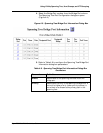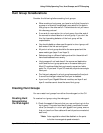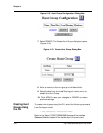
Cajun P550/P880/P882 Switch User Guide
Using VLANs, Spanning Tree, Hunt Groups, and VTP Snooping
4-21
How Hunt Groups Load Share
Hunt Groups load share by allowing different users to use different
ports on the hunt group when sending traffic to a particular user.
Broadcasts and Destination Unknown Unicasts traverse the flood
port (also referred to as the base port).
To understand how load sharing works with the hardware, one
must understand the relationship between users, I/O cards, Fabric
Ports and Packet Lookup Engines (PLEs). For the P550, there are
two fabric ports per I/O slot (slots 2 through 7) and one fabric port
for the CPU slot (slot 1). There is generally one PLE per fabric port
for a layer 2 Card and two PLE’s per fabric port for a layer 3 Card
(with the exception of the 4 port Gigabit Ethernet Card which has
one PLE per port). Each I/O card uses the two fabric ports in the slot
with the exception of the 10 Port 100FX card and the 12 port
10/100 card which only use one fabric port in the slot. Table 4-7 lists
the number of PLEs and fabric ports for the various modules
supported by the Cajun switch.
Table 4-7. Module PLEs and Fabric Ports
Note: All layer 3 I/O modules have a pre-L3 path PLE, and a PLE in the L3 path.
Module Type Total
Number of
PLEs
Number of
Fabric Ports Description
M5500 0 1
M5500R 2 1 FORE port, CPU
10 Port FX (layer 2) 1 1
10 Port FX (layer 3) 2 1
12 Port TX (layer 3) 2 1
2 Port Gigabit (layer 2) 2 2
2 Port Gigabit (layer 3) 4 2
4 Port Gigabit (layer 2) 4 2 2 per fabric port,
1 per port
20 Port TX (layer 2) 2 2


















